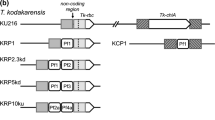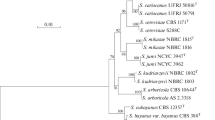Summary
DNA sequences of Candida utilis capable of supporting autonomous replication of plasmids in Saccharomyces cerevisiae were isolated by cloning HindIII restriction fragments of total DNA of C. utilis in the cosmid pHC79-arg4-43 carrying the gene of argininosuccinate-lyase as the selective marker for yeast transformation. Three hybrid plasmids replicating in S. cerevisiae were obtained and growth characteristics of plasmid-carrying cells were investigated. The hybridization experiments show that all hybrid plasmids obtained contain inserts of C. utilis DNA, all of mitochondrial origin. There was no hybridization to S. cerevisiae total DNA observed. One of the hybrid plasmids (pESC17) was characterized in detail. Localization of the replication origin of the cloned fragment was accomplished by recloning of subfragments in the plasmid pHC79-arg4-43. It was shown that effective replication in the yeast cells necessitates the presence of a 300 bp sequence. A primary structure of this DNA fragment showed an extremely high AT content and the absence of GC blocks.
Similar content being viewed by others
References
Chan CSM, Tye B-K (1980) Autonomously replicating sequences in Saccharomyces cerevisiae. Proc Natl Acad Sci USA 77:6329–6333
Clarke L, Carbon J (1978) Functional expression of cloned yeast DNA in Escherichia coli: Specific complementation of argininosuccinate lyase (arg4) mutations. J Mol Biol 120:517–532
Cohen SN, Chang ACY, Hsu L (1972) Nonchromosomal antibiotic resistance in bacteria: Genetic transformation of Escherichia coli by R-factor DNA. Proc Natl Acad Sci USA 69:2110–2114
Crews S, Ojala D, Posakony J, Nishiguchi J, Attardi G (1979) Nucleotide sequence of a region of human mitochondrial DNA containing the precisely identified origin of replication. Nature 277:192–198
Eckhardt T (1978) A rapid method for the identification of plasmid desoxyribonucleic acid in bacteria. Plasmid 1:584–588
Feldman H, Olah J, Friedenreich H (1981) Sequence of a yeast DNA fragment containing a chromosomal replicator and a tRNA Glu3 gene. Nucl Acids Res 9:2949–2959
Gergen JP, Stern RH, Wensink PC (1979) Filter replicas and permanent collections of recombinant DNA plasmids. Nucl Acids Res 7:2115–2136
Hohn H, Collins J (1980) A small cosmid for efficient cloning of large DNA fragments. Gene 11:291–298
Hsiao Ch-L, Carbon J (1979) High-frequency transformation of yeast by plasmids containing the cloned yeast Arg4 gene. Proc Natl Acad Sci USA 76:3829–3833
Hyman BC, Cramer JH, Rownd RH (1982) Properties of a Saccharomyces cerevisiae mtDNA segment conferring high-frequency yeast transformation. Proc Natl Acad Sci USA 79:1578–1582
Kiss GB, Amin AA, Pearlman RE (1981) Two separate regions of the extrachromosomal ribosomal deoxyribonucleic acid of Tetrahymena thermophila enable autonomous replication of plasmids in Saccharomyces cerevisiae. Mol Cell Biol 1:535–543
Kopylova-Sviridova TN, Velkov V, Fodor I, Bayev A (1981) New yeast vectors on the basis of mitochondrial DNA of Saccharomyces cerevisiae. Doklady USSR Acad Sci (Russ) 259:990–992
Livingston DM, Klein HL (1977) Deoxyribonucleic acid sequence organization of a yeast plasmid. J Bacteriol 129:472–481
Mackey JK, Brackman KH, Green MR, Green M (1977) Preparation and characterization of highly radioactive in vitro labeled adenovirus DNA and DNA restriction fragments. Biochemistry 16:4478–4483
Maxam AM, Gilbert W (1980) Sequencing of end labeled DNA with base specific chemical cleavage. In: Grossman L, Moldave K (eds) Methods in enzymology, vol 65. Academic Press, New York, pp 499–560
Meyers JA, Sanchez D, Elwell LP, Falkow S (1976) Simple agarose gel electrophoretic method for the identification and characterization of plasmid deoxyribonucleic acid. J Bacteriol 127:1529–1537
Polisky B, Green P, Garfin DE, McCarthy BJ, Goodman HM, Boyer HW (1975) Specificity of substrate recognition by the EcoRI restriction endonuclease. Proc Natl Acad Sci USA 72:3310–3314
Southern EM (1975) Detection of specific sequences among DNA fragments separated by gel electrophoresis. J Mol Biol 98:503–517
Sriprakash KS, Molloy PL, Nagley P, Lukins HB, Linnane AW (1976) Biogenesis of mitochondria XLI. Physical mapping of mitochondrial genetic markers in yeast. J Mol Biol 104: 485–503
Stinchcomb DT, Struhl K, Davis RW (1979) Isolation and characterization of a yeast chromosomal replicator. Nature 282:39–43
Stinchcomb DT, Thomas M, Kelly J, Selker E, Davis RW (1980) Eukaryotic DNA segments capable of autonomous replication in yeast. Proc Natl Acad Sci USA 77:4559–4563
Tanaka T, Weisblum B (1975) Construction of a colicin E1-R factor composite plasmid in vitro: Means for amplification of deoxyribonucleic acid. J Bacteriol 121:354–362
Tschumper G, Carbon J (1980) Sequence of a yeast DNA fragment containing a chromosomal replicator and the trp1 gene. Gene 10:157–166
Tschumper G, Carbon J (1982) Delta sequences and double symmetry in a yeast chromosomal replicator region. J Mol Biol 156:293–307
Zakian V (1981) Origin of replication from Xenopus laevis mitochondrial DNA promotes high-frequency transformation of yeast. Proc Natl Acad Sci USA 78:3128–3132
Zamoroczy de M, Marotta R, Faugeron-Fonty G, Goursot R, Maugin M, Baldacci G, Bernardi G (1981) The origins of replication of the yeast mitochondrial genome and the phenomen of suppressivity. Nature 292:75–78
Author information
Authors and Affiliations
Additional information
Communicated by H. Böhme
Rights and permissions
About this article
Cite this article
Tikhomirova, L.P., Kryukov, V.M., Strizhov, N.I. et al. mtDNA sequences of Candida utilis capable of supporting autonomous replication of plasmids in Saccharomyces cerevisiae . Molec. Gen. Genet. 189, 479–484 (1983). https://doi.org/10.1007/BF00325913
Received:
Issue Date:
DOI: https://doi.org/10.1007/BF00325913




